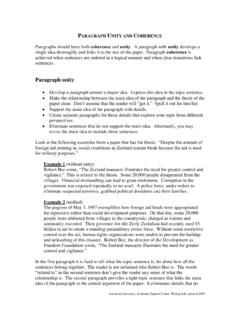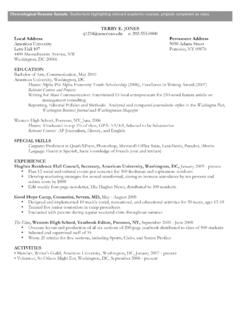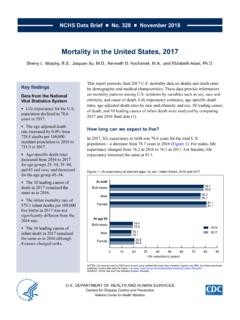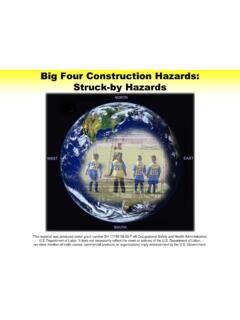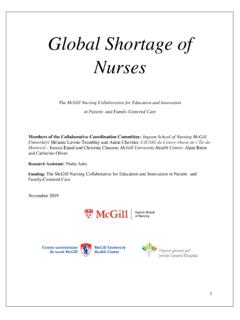Transcription of The Water Crisis in Kenya: Causes, Effects and Solutions
1 31 Global Majority E-Journal, Vol. 2, No. 1 (June 2011), pp. 31-45 The Water Crisis in Kenya: causes , Effects and Solutions Samantha Marshall Abstract Located on the eastern coast of Africa, Kenya, a generally dry country with a humid climate, is enduring a severe Water Crisis . Several issues such as global warming (causing recurrent and increasingly severe droughts as well as floods), the contamination of drinking Water , and a lack of investment in Water resources have enhanced the Crisis .
2 This article provides an overview of Kenya s Water Crisis , along with a brief review of the literature and some empirical background. It reviews the main causes of the Water Crisis and how it affects the health of millions of Kenyans. Furthermore, the article summarizes some of the main Solutions proposed to overcome the Crisis . I. Introduction There are about 40 million people living in Kenya, of which about 17 million (43 percent) do not have access to clean For decades, Water scarcity has been a major issue in Kenya, caused mainly by years of recurrent droughts, poor management of Water supply, contamination of the available Water , and a sharp increase in Water demand resulting from relatively high population growth.
3 The lack of rainfall affects also the ability to acquire food and has led to eruptions of violence in Kenya. In many areas, the shortage of Water in Kenya has been amplified by the government s lack of investment in Water , especially in rural areas. Most of the urban poor Kenyans only have access to polluted Water , which has caused cholera epidemics and multiple other diseases that affect health and livelihoods. Despite the critical shortage of clean Water in Kenya s urban slums, there also is a large rural to urban discrepancy in access to clean Water in Kenya.
4 According to the World Bank (2010), slightly less than half of the rural population has access to Water , as opposed to the urban population where 85 percent have access to safe Water . Due to continued population 1 See World Bank (2010). 32 growth, it has been estimated that by the year 2025, Kenya s per capita Water availability will be 235 cubic meters per year, about two-thirds less than the current 650 cubic This article is about the causes , Effects and Solutions to the Water Crisis in Kenya.
5 The next section provides a brief review of the literature on the Kenyan Water Crisis . The subsequent section provides some empirical background on Kenya. The fourth and fifth sections discuss, respectively, how the Water Crisis developed and what Effects it has on the country. Section six summarizes some recent suggestions for Solutions before the last section provides some conclusions. II. Brief Literature Review There is a large and growing literature addressing a variety of issues related to Kenya s decade old Water Crisis .
6 One of the first systematic analyses of Kenya s Water resources had been undertaken by the British Crown in 1934 (when Kenya was a colony of the British empire).3 The literature experienced some growth after Kenya gained independence in 1963, with various seminal contributions in the early By the 1980s, much of the literature addressed specific issues, like for example the report by the Kenya Water for Health Organization (1985), focusing on the implications of the Kenyan Water Crisis on women.
7 By 1990, the first annotated bibliography on soil and Water conservation in Kenya had been provided by Karanja and Tefera (1990). In the more recent years, the focus of Kenya s Water Crisis has shifted to the impact of climate change and climate variability; see for example the detailed study by Mogaka, Gichere, Davis and Hirji (2006). Furthermore, after decades of policy neglect, the Government of Kenya s (2008) Poverty Reduction Strategy Paper (PRSP) has finally recognized the importance of safe Water for its goal to reduce poverty.
8 The PRSP discusses the Water situation, challenges to overcome the Water Crisis , and multiple approaches to tackle the problem. Among the most recent contributions are various informative news articles which illustrate the severity as well as the complexity of Kenya s Water Crisis . Several articles focus on how Water contamination leads to illnesses and death. Other articles touch upon different factors of the Crisis and some stick to one specific factor, such as recurrent droughts, which have affected millions of Kenyans.
9 One very interesting article, devised by the Women News Network s Kenya correspondent Gitonga Njeru (2010), focuses on how the Water Crisis in Kenya has had a tremendous impact on maternal care. The Kakamega Provincial District General Hospital in Kenya lacks the sufficient supply of clean Water . Njeru says that the patients health conditions are made worse by severe Water shortages. Due to the Water shortage, hospitals like Kakamega Provincial District General Hospital have to collect buckets of Water , which is then provided to its patients.
10 The Water is polluted with bacteria, viruses and parasites and many patients develop different diseases such as typhoid and cholera. Not being able to 2 See Wafula (2010). 3 See Kenya Colony and Protectorate (1934). 4 See for example Padfield (1971) and Carruthers (1973). 33 provide safe Water results in a serious threat to the health of expectant mothers. The facts are clear, Njeru states, climate change, Water supply and sanitation play a responsible role in many of these deaths.




